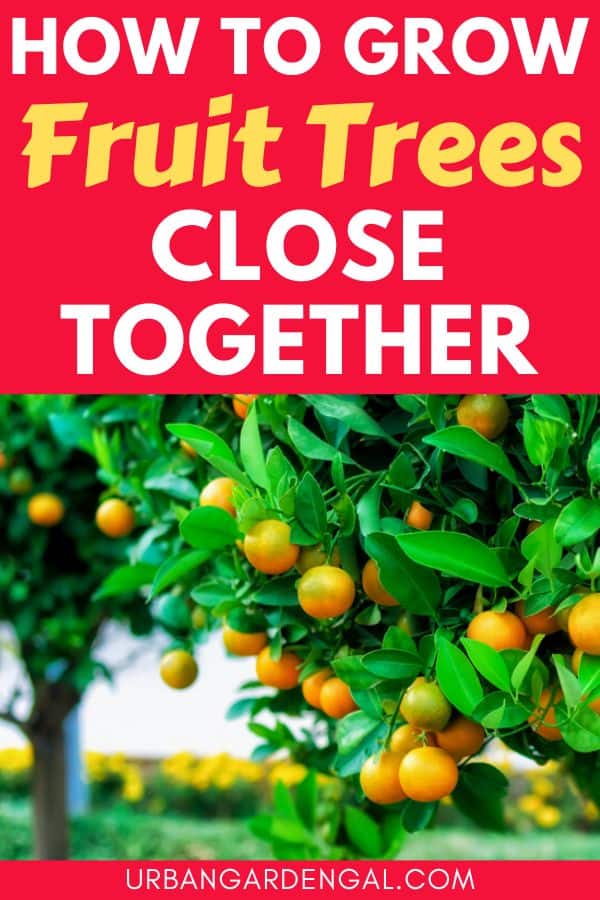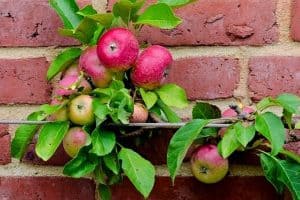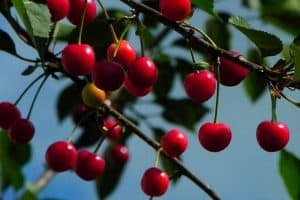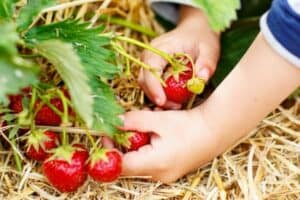Growing fruit trees close together is a great way to maximize your garden space.
As a landscape gardener specializing in small space gardens, I’ve had good results planting fruit trees close together without sacrificing yield or quality.
In fact, there are several benefits to growing fruit trees in a small space, such as increased pollination and easier maintenance.
In this article I’ll explore the advantages of high density fruit tree planting and provide tips for maximizing your harvest in a limited space.
This post contains affiliate links. Please read the disclosure for more info.
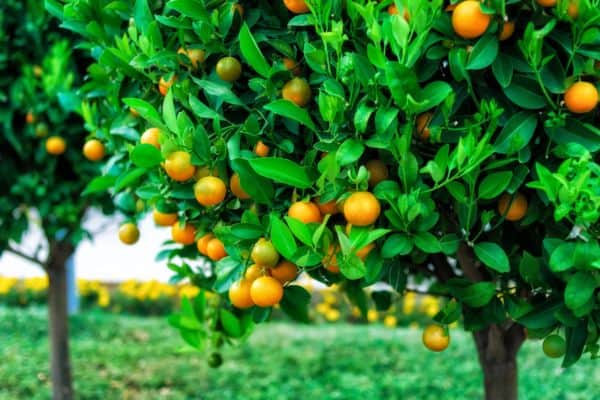
Benefits of Planting Fruit Trees Close Together
Planting fruit trees in close proximity creates a high-density planting area.
This means you can grow different varieties in a relatively small space, allowing for successive ripening of fruits.
You’ll enjoy a continuous harvest throughout the growing season because each variety matures at different times.
This can provide you and your family with a diverse and steady supply of fresh fruit.
Another advantage of high-density planting is that it makes maintenance more manageable.
Pruning, watering, and pest management can all be done more efficiently when trees are planted close together in your backyard orchard.
With less ground to cover, you can ensure the proper care for each tree with less time and effort.
Lastly, planting fruit trees close together can also create more opportunities for cross-pollination.
Many fruit trees can benefit greatly from cross-pollination, as it often results in larger and more abundant fruits, as well as fewer blossom and fruit drop issues.
By planting various fruit trees in close proximity, you increase the chances of cross-pollination, leading to a more bountiful harvest.
Selecting Suitable Fruit Trees
Apples, plums, and peaches are all excellent choices for close planting.
These fruit trees can be kept relatively small because they’re adaptable to different pruning techniques.
You’ll be able to enjoy a variety of fresh fruits from these trees within your own garden space.
Citrus trees, including limes, lemons, oranges, and grapefruits, can also be planted relatively close together but they have a spreading growth habit, so they’ll need regular pruning so they don’t compete too much with neighboring trees
Fig, pear, and nectarine trees are another fantastic option for high-density planting because of their adaptability and they can be easily pruned to control their size.
Lastly, consider loquat trees as an addition to your high-density planting scheme.
These trees are smaller and can be a lovely ornamental addition to your garden, all while providing delicious fruits.
RELATED: How to Keep Loquat Trees Small
Best Fruit Tree Varieties
Dwarf and semi-dwarf trees are an excellent choice for close planting, as they tend to have smaller, more manageable sizes.
According to the University of Minnesota Extension, dwarf apple trees will start bearing fruit 2 to 3 years after planting.
Some popular fruit tree varieties to consider include dwarf varieties of:
- Apple trees: Gala, Fuji, and Honeycrisp.
- Pear trees: Bartlett and Bosc.
- Peach trees: Bonanza and Honey Babe.
- Plum trees: Santa Rosa and Beauty.
- Citrus trees: Dwarf varieties of orange, lemon, and lime trees.
Planting Techniques
When you’re planning to plant fruit trees close together, it’s essential to consider the most suitable planting techniques for your garden.
One popular method, especially for small spaces, is the espalier technique.
In this technique, fruit trees are planted along a support structure like a wall or fence.
You train the branches to grow flat, creating a two-dimensional appearance. Espalier allows you to maximize growing space and makes it easy to harvest your fruit.
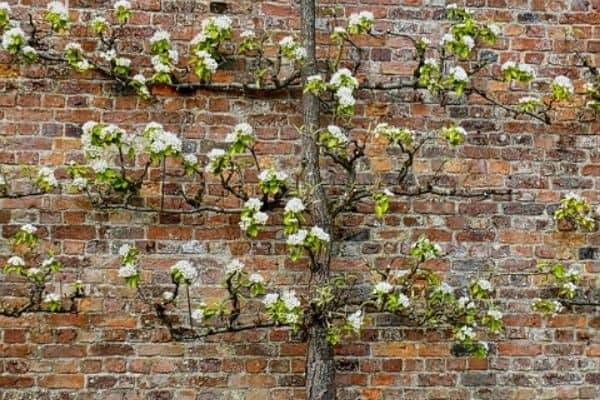
Another option is the hedgerow technique, where you plant fruit trees in a row, close together. This creates a boundary or hedge effect, which can look impressive and provide plenty of fruits.
When you’re digging holes for planting, ensure the holes are about twice as wide as the existing root ball and make sure the top of the root ball is level with the ground.
Here are some key considerations for different tree types:
- Apples: Plant dwarf varieties 4 to 8 feet (1.4 to 2.8 metres) apart.
- Pears: For dwarf pear trees, a spacing of 10 to 15 feet (3 to 4.5 metres) apart is suitable.
- Stone fruits: These include peaches, nectarines, and plums. Plant dwarf varieties at least 8 feet (2.8 metres) apart.
Cross-Pollination and Pollinators
Some fruit trees are self-pollinating, which means they can produce fruit without the need for a separate tree to provide pollen.
However, many fruit trees require cross-pollination to produce a healthy and abundant crop. In this case, it’s essential to have two or more compatible trees planted close enough for pollinators to transfer pollen between them.
Cross-pollination occurs when pollen from one tree’s flower is transferred to the flower of another tree. This process is vital for the development of fruit on many types of trees, as it ensures genetic diversity and can often lead to more robust fruit production.
Pollinators play a crucial role in the cross-pollination process.
Bees, in particular, are efficient pollinators of fruit trees. Other pollinators, like wasps, can also contribute to fruit tree pollination, but they are less efficient than bees.
To encourage pollinators like bees and wasps in your orchard, add some plants that attract them like lavender, borage and coneflowers.
Offering a diversity of flowering plants can help support a healthy ecosystem in your garden, which in turn can lead to more productive fruit trees.
Pruning and Canopy Management
Pruning and canopy management are essential for maintaining the health of your fruit trees, especially when they are planted close together.
By implementing proper pruning techniques, you can ensure that your trees receive adequate light and air circulation, resulting in a more productive backyard orchard.
Ideally you should prune your fruit trees twice a year. The first pruning session should take place during the summer to control the trees’ size and vigor.
This will help to keep their size manageable and ensure that the canopy remains open to allow sunlight in.
A well-managed canopy allows you to balance vegetative growth with reproductive growth. This balance is crucial for maintaining healthy fruit trees and consistent harvests throughout the seasons.
The second pruning session should be done in late winter or early spring to remove any dead, diseased or damaged branches.
Soil, Nutrients, and Fertilizers
When you’re planting fruit trees close together, it’s essential to pay attention to the soil, nutrients, and fertilizers. Healthy soil will ensure your trees have a strong foundation to support their growth and resist diseases.
It’s a good idea to do a soil test before planting your fruit trees. This will help you determine the specific nutrients your soil lacks and the proper amendments to add.
Fruit trees require a mix of macronutrients like nitrogen, phosphorus, potassium, calcium, magnesium, and sulfur. [1]
These nutrients are crucial for proper growth, fruit production, and overall tree health.
When fertilizing, it’s vital to use the right balance of nutrients, especially when planting multiple fruit trees close together, as this increases competition for these essential nutrients.
It’s best to use a fertilizer specifically tailored to fruit trees like this one.
Pest and Disease Control
Planting fruit trees close together has its advantages, but it can also make it easier for pests and diseases to spread from tree to tree.
Firstly, choose disease-resistant varieties, especially when planting trees from the Rosaceae family like apples, pears, and cherries. This reduces the risk of diseases like fire blight or powdery mildew affecting your trees.
You should also consider using companion plants in your orchard. These plants can help deter pests and attract beneficial insects.
For example, planting garlic or chives near your fruit trees can help keep aphids and other harmful insects away.
Similarly, flowers like marigolds and nasturtiums can attract pollinators and repel pests.
Keep your backyard orchard clean to prevent the spread of diseases.
Remove fallen leaves, fruit, and any other debris that might harbor bacteria, fungi, or pests.
Pruning your trees regularly will help to improve air circulation, reduce the risk of fungal infections, and make it harder for pests to move from tree to tree.
Monitor your trees for any signs of pests or diseases. Early detection is key in dealing with these issues effectively.
If you spot any problems, use targeted treatments like horticultural oils, insecticidal soaps, or biological controls like ladybugs and lacewings to manage pests.
For diseases, consider using organic fungicides or bactericides when necessary.
By following these strategies and staying vigilant, you can promote a healthy, productive high-density orchard.
RELATED ARTICLES
- 11 Best Fruit Trees To Grow In Containers
- How To Keep Birds Away From Fruit Trees
- 10 Climbing Fruit Plants
- How to Keep Lemon Trees Small
- 7 Cool Climate Fruit Trees
So there are my tips for creating an abundant small backyard orchard with high density fruit tree planting.
Are you on Pinterest? I have boards dedicated to Growing Fruit and Urban Gardening that you may enjoy. You can also find me on Facebook.

